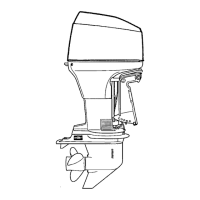- 10 -
3. Apply Quicksilver Anti-Corrosion Grease to entire
shaft.
4. Install thrust washer (a), propeller (b), propeller
nut retainer (c), and propeller nut (d) onto the
shaft.
5. Place a block of wood between gear case and
propeller and torque propeller locknut to 55 lb. ft.
(75 N·m), aligning tabs of washer with flat grooves
of propeller hub.
6. Secure propeller nut by bending three of the tabs
into the thrust hub grooves.
b
c
d
a
a - Thrust Washer
b - Propeller
c - Propeller Nut Retainer
d - Propeller Nut
Power Trim System
General Information
The power trim system is filled at the manufacturer
and is ready for use.
Trim outboard through entire trim and tilt range sever-
al times to remove any air from the system.
The trim system is pressurized and is not externally
vented.
Power Trim Operation
With most boats, operating around the middle of the
“trim” range will give satisfactory results. However, to
take full advantage of the trimming capability there
may be times when you choose to trim your outboard
all the way in or out. Along with an improvement in
some performance aspects comes a greater respon-
sibility for the operator, and this is being aware of
some potential control hazards. The most significant
control hazard is a pull or “torque” that can be felt on
the steering wheel or tiller handle. This steering
torque results from the outboard being trimmed so
that the propeller shaft is not parallel to the water sur-
face.
IMPORTANT: Avoid possible serious injury or
death. When the outboard is trimmed in or out be-
yond a neutral steering condition, a pull on the
steering wheel or tiller handle in either direction
may result. Failure to keep a continuous firm grip
on the steering wheel or tiller handle when this
condition exists can result in loss of boat control
as the outboard can turn freely. The boat can now
“spin out” or go into a very tight maximum turn
which, if unexpected, can result in occupants be-
ing thrown within the boat or out of the boat.
Consider the following lists carefully.
TRIMMING IN OR DOWN CAN:
1. Lower the bow.
2. Result in quicker planing off, especially with a
heavy load or a stern heavy boat.
3. Generally improve the ride in choppy water.
4. Increase steering torque or pull to the right (with
the normal right hand rotation propeller).
5. In excess, lower the bow of some boats to a point
where they begin to plow with their bow in the wa-
ter while on plane. This can result in an unex-
pected turn in either direction called “bow steering”
or “over steering” if any turn is attempted or if a sig-
nificant wave is encountered.
!
WARNING
Avoid possible serious injury or death. Adjust
outboard to an intermediate trim position as soon
as boat is on plane to avoid possible ejection due
to boat spin-out. Do not attempt to turn boat when
on plane if outboard is trimmed extremely in or
down and there is a pull on the steering wheel or
tiller handle.
TRIMMING OUT OR UP CAN:
1. Lift the bow higher out of the water.
2. Generally increase top speed.
3. Increase clearance over submerged objects or a
shallow bottom.
4. Increase steering torque or pull to the left at a nor-
mal installation height (with the normal right hand
rotation propeller).
5. In excess, cause boat “porpoising” (bouncing) or
propeller ventilation.
6. Cause engine overheating if any water intake
holes are above the water line.

